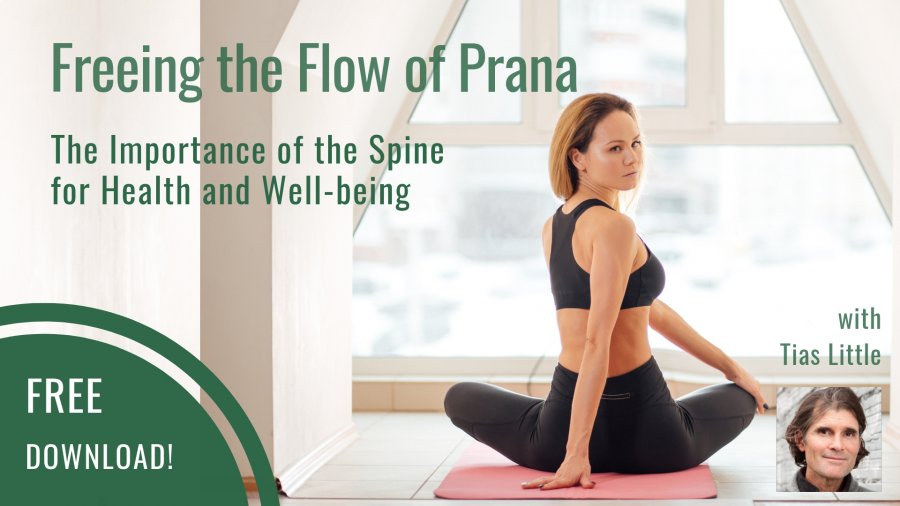Free Download! Freeing the Flow of Prana: The Importance of the Spine for Health and Well-being
Course Info
- Price:
- $0.00
Tias Little
 Tias Little synthesizes years of study in classical yoga, Sanskrit, Buddhist studies, anatomy, massage, and trauma healing. Tias began studying the work of B.K.S Iyengar in 1984 and lived in Mysore India in 1989 studying Ashtanga Vinyasa Yoga with Pattabhi Jois. Tias is a licensed massage therapist...
Tias Little synthesizes years of study in classical yoga, Sanskrit, Buddhist studies, anatomy, massage, and trauma healing. Tias began studying the work of B.K.S Iyengar in 1984 and lived in Mysore India in 1989 studying Ashtanga Vinyasa Yoga with Pattabhi Jois. Tias is a licensed massage therapist... 
An often repeated expression in yoga says that, “Your body is as young as your spine is flexible.” It’s an acknowledgment of how the spine serves as the body’s center of health and well-being and plays a key role in longevity.
In this free download, acclaimed yoga teacher Tias Little describes how we can nurture and support our spinal health and resilience via the right yoga practice. Tias explains that the spine serves as both the epicenter of physical movement and the master vehicle of communications, both into and out from the body.
By maintaining the health of all the tissues around the spine, we facilitate more buoyancy and greater fluid exchange through the tissues, including the discs. But more than that, we also foster a buoyancy of spirit, increased awareness, and a greater sense of vitality.
“Mobilizing the spinal joints in order to encourage the flow of neurological information right through the spine strikes right at the heart of yoga,” Tias states. “In classical yoga it is the sushumna or that central part of the spine, which is always emphasized.”
All movement, even micro movements of the jaw, relate to the spine, the brainstem and the brain itself. “The brain as really the fruit of the spine or the fruit of the trunk of their spine. Any movement along the spine will directly affect the brain tissue, neurological supply through the brain,” says Tias.
Tias likens working with the spine to the metaphor of bamboo: When it's made supple in all directions, longevity occurs. He shows how moving slowly, including micro movements, and bringing awareness all the way to the sensations in the baby toes, we are able to maintain spinal resilience and rehabilitate sensory motor pathways.
“I always wondered in the early years of studying Iyengar Yoga, “What's the big deal about spreading the little toe? Why a hundred cues about spreading little toe and mobilizing the outer foot?” he laughs. “Now we know that the neurological supply to every little nook and cranny of the body hearkens back to the spinal shaft.”
Micromovement–bringing lots of movement and therefore more wakefulness and sensory information into the sensory motor feedback loop–is key to therapeutic yoga applications. Through mobilizing the small joints, we also mobilize the peripheral nervous system.
“The beautiful thing is that our bodies are so plastic and able to rewire that no matter one's age or personal history, it's possible to regain neurological supply into the periphery and peripheral nervous system by moving the small joints of hands and feet or the larger structures of the arms and the legs,” he explains.
Tias describes the spine as the central access through which flows divine life force, called prana. He correlates this yogic notion to the study of structure in western anatomy in which the spinal cord holds the life force. “The spine is really the shaft of life,” he exclaims.
“All of Hatha yoga is really the energizing of the spine, the amplifying of the spinal energy. We do postures to the left, triangle to the right, backbends and forward bends–all in order to really clarify the life force in the spine. This relates to the brain and the brain stem and the higher chakras. Meditation, for example, is supported by good spinal mechanics, but biomechanics along with concentrated awareness.”
You may enjoy Tias's course, The Spine as a Sacred Channel: Nourishing the Ecosystem of the Spine for Lifelong Back Health.